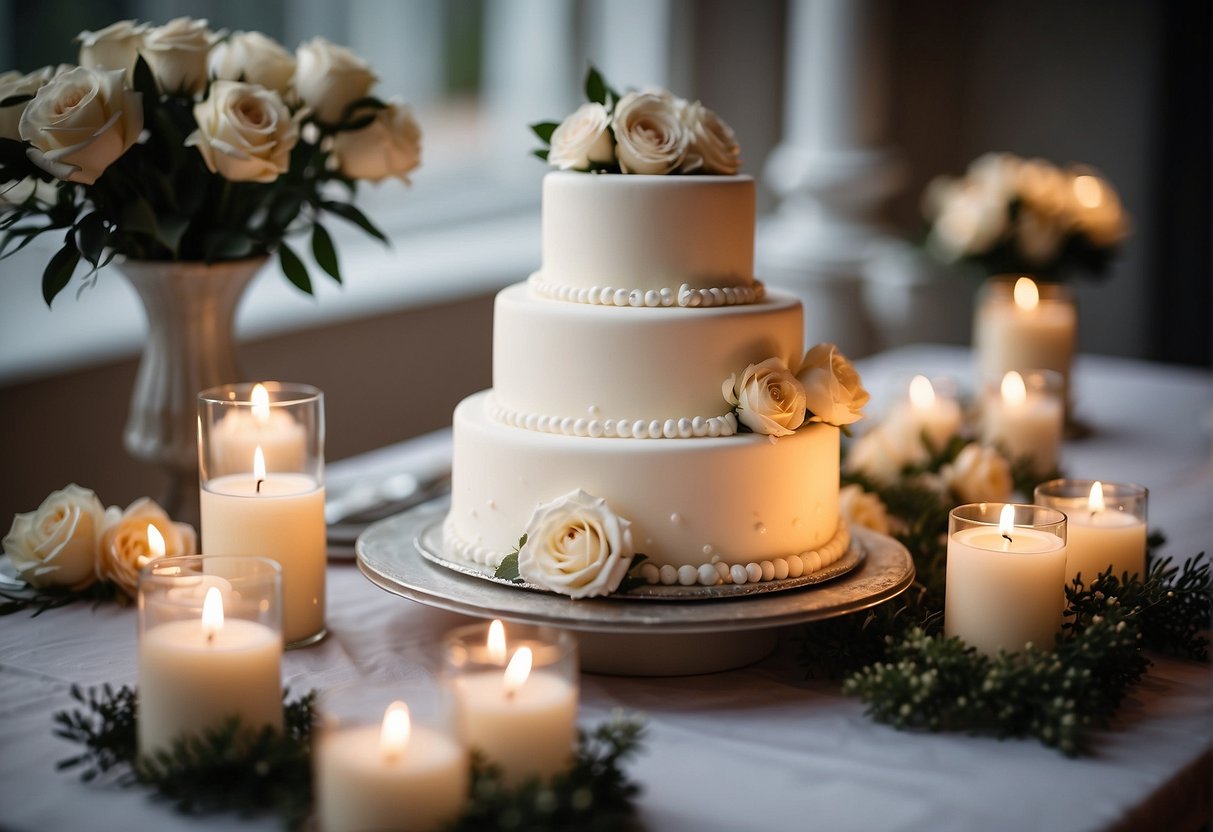Crafting a cake for a First Holy Communion is a meaningful ritual that marks a significant milestone in many Christian denominations, symbolizing a child’s first reception of the sacrament of the Eucharist. The communion cake serves not only as a decorative centerpiece but also embodies the sanctity of the occasion, reflecting the spiritual significance and joy of this important rite of passage. As a baker or family member preparing for the event, the cake I choose or create holds a special place in commemorating the day, blending tradition with personal touches.

The styles and designs for First Communion cakes are diverse, ranging from the traditional to the creative. Some may opt for a cross-shaped cake adorned with religious symbols fashioned from fondant, while others might prefer a simple yet elegant design featuring a chalice or a dove, representing the Holy Spirit. The cake can be customized to match the theme of the celebration or the child’s personal tastes, making it a unique and memorable aspect of the First Communion.
Choosing the right cake involves considering factors like flavor, size, and decoration. Beyond aesthetics, it’s essential that the cake appeals to the palate of the young communicant and guests. Whether it’s a classic white vanilla cake with buttercream frosting or a more elaborate multi-layer creation, every aspect of the First Communion cake holds significance. It’s a privilege to craft a dessert that adds sweetness to a day filled with spiritual meaning and family celebration.
Significance and Symbolism

First Communion cakes are not merely celebratory confections, they carry deep religious importance and are steeped in symbolism that reflects the sacredness of the occasion.
Religious Symbolism
The sacrament of the First Holy Communion is a revered tradition in the Catholic Church, marking the first reception of the Eucharist, where the faithful receive the body and blood of Christ symbolically. Consequently, communion cakes often embody elements that reflect this spiritual milestone. The use of a cross or rosary decoration on the cake signifies the religious undertones of the occasion. A dove, representing the Holy Spirit, is another powerful symbol commonly incorporated into the design.
Color and Design Choices
Traditionally, white buttercream is used to align with the purity and new beginnings that First Communion signifies. Color choices tend to be subtle, with white being predominant; however, gentle hues like purple, pearl or lavender can also be found, alluding to royalty and the sacred. Designs may include stained glass patterns made of colored fondant, which are reminiscent of church windows and the light they cast.
Popular Themes and Icons
A variety of religious themes and icons are popular in First Communion cakes. Besides the cross, edible rosary beads made from fondant or icing are a favored choice. Themes may vary from simple to elaborate, with some cakes featuring fondant recreations of the Bible, grapes, bread, or even scenes from the scriptures. It is common to see a cake topped with a fondant chalice – a nod to the sacramental wine, symbolic of Jesus’s blood during the Eucharist, and sometimes adorned with grapes – a symbol of the fruitfulness of the Christian life.
Planning Your First Communion Cake

When organizing a first communion celebration, selecting the ideal cake is crucial for creating a stress-free event that complements this significant milestone. Below, I outline the essential steps for choosing the right cake style and pairing it with delightful flavors and fillings.
Selecting the Right Cake Style
The style of the cake should befit the solemnity and joy of a first communion. I prefer to opt for either a traditional look or something unique to the celebrant. Traditional communion cakes often resemble an open book or feature religious symbols like a cross. For a more personalized touch, a doll cake dressed in traditional communion attire can be a hit, especially for young girls.
- Traditional Shapes: Open book cake, Cross cake
- Unique Designs: Doll cake with appropriate dress
Additionally, for those who desire something less conventional, communion cupcakes can be an excellent choice. They’re not only easy to distribute, but they also allow for a variety of designs that can cater to each guest’s taste.
Flavors and Fillings
Next, selecting the cake’s flavor and accompanying fillings is another essential step. While a vanilla sponge is a crowd-pleaser, I like to offer guests a variety of tastes. A rich chocolate ganache or a luscious mascarpone cheese filling can add a level of sophistication to the dessert. The choice of sugar content should be balanced, to err on the side of moderation, in keeping with the essence of the occasion.
Flavors:
- Classic: Vanilla, Chocolate, Lemon
- Unique: Red Velvet, Carrot, Madeira Sponge
Fillings:
- Simple: Buttercream, Whipped Cream
- Deluxe: Chocolate Ganache, Mascarpone Cheese, Fruit Preserves
By choosing the right style and pairing it with delectable flavors and fillings, I ensure that the first communion cake not only looks splendid but also tastes divine, making the dessert a memorable part of this special day.
Decorating Techniques

I understand that the focal point of any First Communion celebration is often the cake, which acts both as a centerpiece and a delicious dessert. Mastering a few decorating techniques can turn a simple homemade cake into a stunning creation befitting this important sacrament. Here, I will discuss some specific methods to achieve that.
Fondant and Sugarcraft
In my experience, using fondant is a versatile approach to create a sleek, professional finish for a Holy Communion cake. Sugarpaste, commonly referred to as fondant, can be rolled out and draped over the cake to create a smooth canvas. Gumpaste, which is similar but dries harder due to the addition of tylose powder, is excellent for crafting intricate cake decorations like chalices, doves, or crosses. I often utilize various piping skills to add details to these figures, making them more lifelike and appropriate as communion cake toppers.
- Tools Needed:
- Fondant smoother
- Rolling pin
- Gumpaste modeling tools
- Tylose powder
Buttercream and Icing
White buttercream is a classic choice for a First Communion cake, offering a pristine look. I have improved my piping skills over the years to include a variety of buttercream flowers, which can be piped directly onto the cake or onto parchment paper and transferred once set. For those who aspire to be an ‘I am baker’ or a ‘Bakerella’, mastering the art of royal icing can provide an additional glossy, firm decoration that’s perfect for more delicate designs.
- Key Techniques:
- Smooth coating
- Piped flowers
- Basketweave pattern
- Borders and edging
Adding Personal Touches
Finally, personalizing a First Holy Communion cake makes it truly special. Fresh flowers, carefully washed and prepared, can add natural beauty to the cake. Handmade or purchased holy communion cake toppers, such as a bible or a pair of praying hands, make for meaningful focal points. Whether you’re a seasoned cake decorator or making a homemade first communion cake for the first time, adding these personal elements will convey a sincere reflection of this significant milestone.
- Ideas for Personalization:
- Inscription with the child’s name
- Date of the First Communion
- Custom sugarcraft symbols (chalice, grapes, wheat)
- Edible images or scriptures
Baking the Cake

Baking a cake for a First Communion is a special endeavor, whether you choose to make it from scratch or order from a bakery. Key considerations like the choice of ingredients and the necessary tools will greatly impact the final product.
Homemade versus Bakery
Homemade Communion Cake:
- Ingredients: I prefer to use quality ingredients for a homemade cake, ensuring a rich and delicious flavor. A typical madeira sponge cake, for instance, requires basic ingredients like flour, eggs, sugar, and butter.
- Directions: Following a precise recipe is crucial. I beat egg whites with water until stiff peaks form, sweeten with sugar, and gently fold in the yolks for a light, airy base.
Bakery Cake:
- I might select a bakery First Communion cake if I’m looking for convenience or a professional touch. Bakeries can offer a variety of cake mixes and flavors that might be challenging to replicate at home.
- Cupcakes: Another option offered by bakeries is communion-themed cupcakes, which can be a hit for their individual serving size and ease of distribution.
Essential Baking Tools
For Homemade Cake:
- Sharp Knife: I’ll need a sharp knife for leveling the cake layers to ensure a stable and professional-looking cake.
- Spatula: A spatula is indispensable for evenly spreading batter in the pan and for frosting the finished cake.
Cake Tools Table:
| Tool | Purpose |
|---|---|
| Sharp Knife | For leveling and cutting the cake |
| Spatula | For spreading batter and applying frosting |
| Measuring Cups | For accurate ingredient measurements |
| Electric Mixer | For beating egg whites and incorporating ingredients smoothly |
In either scenario, whether I opt for a homemade cake or one from the bakery, careful attention to the process and tools involved is necessary to create a memorable First Communion cake.
Final Touches and Presentation

When presenting a First Communion cake, final touches can make a substantial difference. I focus on ensuring the cake not only tastes good but also looks immaculate and carries the significance of the occasion. Here are the details on how to nail the presentation.
Assembly and Transport
Assembly: I make sure all decorations, such as sprinkles or white chocolate accents, are secure. Attention to detail is crucial; I carefully position any fondant figures or piped designs. For a cross cake, I ensure the shape is symmetrical.
Transport: Transporting a first communion cake requires a stable base. I use a thick, corrugated cardboard that’s larger than the cake itself for a cross cake, or a sturdy cake box for rectangular options. To prevent movement, non-slip mats can be a lifesaver, especially for delicate communion theme cakes.
Display and Serving
Display: The first communion cake is a centerpiece, so I select a prominent table. I prefer a white cloth to echo the purity of the event. The cake stand should not only complement the cake but also be steady, especially for tiered designs.
Serving: Clean, sharp knives are essential for a perfect slice, and I usually have a server ready for transferring pieces to plates. Serving time depends on the flow of the communion party; it’s often best after the meal has been enjoyed.
Photography and Momentos
Photography plays a crucial role in capturing the beauty of first communion cakes. I take photos prior to the event, using natural light if possible. It’s important to capture different angles, highlighting the intricate details. I also suggest having guests take photos as an interactive part of the communion party. These pictures become treasured momentos, and it’s helpful to have a page dedicated to these memories in a first communion album.
Additional Resources

When preparing a First Communion celebration, I find that it’s essential to have access to helpful online tutorials and guidance, as well as an understanding of the liturgical context. The following resources will guide you through creating the perfect Communion cake and imbuing your celebration with meaningful symbolism.
Online Tutorials and Guides
For those looking to bake and decorate a First Communion cake themselves, numerous online tutorials are available. Websites like I Am Baker and Bakerella offer step-by-step instructions on creating stunning cake designs that can range from simple elegance to more complex decorations. They also provide tips on techniques for sculpting cake into shapes like crosses or using fondant to design liturgical symbols.
- I Am Baker: Features cake recipes and decoration ideas with clear, illustrated guides.
- Bakerella: Offers detailed baking tips, especially for themed cakes and intricate designs.
Liturgical Context
Understanding the liturgical context of First Communion aids in selecting appropriate symbols and colors for the cake. The liturgical year encompasses various events including Christenings and First Communions, each with its own set of traditional color palettes and motifs. For example, white is symbolic of purity, whereas black is generally avoided for such celebrations.
- Liturgical themes: Focus on incorporating symbols like the chalice, bread, and grapes.
- Color choice: Prefer white and gold to align with the themes of purity and celebration.
By considering online guides and the rich traditions of the liturgical year, I ensure my communion cakes are both visually appealing and spiritually meaningful.
Frequently Asked Questions

In this section, I address some common queries associated with choosing and preparing a cake for a First Communion celebration. From design ideas to flavors and presentation, I’ve got your questions covered.
What are some popular cake design ideas for a girl’s First Communion?
For a girl’s First Communion, I often find cakes that feature delicate details such as flowers, crosses, and religious symbols to be quite popular. Some cakes include edible figurines of a girl dressed in white or have designs resembling a communion dress. Adding subtle color accents, like pale pinks or gold, can create a modern yet reverent appearance.
Where can I find unique toppers for a First Communion cake?
Unique toppers for a First Communion cake can be sourced from specialty baking stores or online retailers. Custom toppers, such as personalized messages, figurines resembling the communicant, or religious symbols like crosses or doves, are also available and can add a distinctive touch to the cake.
Are there specific cake flavors that are traditional for First Communion celebrations?
Traditionally, First Communion cakes are often vanilla or white sponge to align with the symbolism of purity and the color white. However, it’s not uncommon to choose from a variety of flavors based on the recipient’s preferences, including chocolate, lemon, or even red velvet.
How can I choose a cake design for a boy’s First Holy Communion?
When choosing a cake design for a boy’s First Holy Communion, I recommend considering classic and masculine elements such as a chalice, a bible, or a suit-inspired motif. Simplicity works well, with minimal color palettes like blues and whites, and clean lines for an elegant and respectful style.
What are options for a simple yet elegant First Communion cake?
A simple yet elegant First Communion cake can be achieved with a minimalist design, such as a white cake with a smooth fondant finish, accented with a few strategically placed edible pearls or a single sugar floral arrangement. Sometimes, a fondant ribbon or a simple cross can be all that’s needed for a tasteful presentation.
What types of food and beverages are typically served at a First Communion party?
At a First Communion party, light refreshments and finger foods are commonly served, including sandwiches, fruit platters, and pastries. As for beverages, sparkling juices, tea, and coffee are suitable choices that accommodate all ages and uphold the respectful tone of the occasion.
- 15 Football-Themed Snack Ideas for Kids & Teens - September 9, 2024
- 15 Mistake Quotes For Kids - September 7, 2024
- Fun Shark Quotes and Sayings For Kids - September 7, 2024








